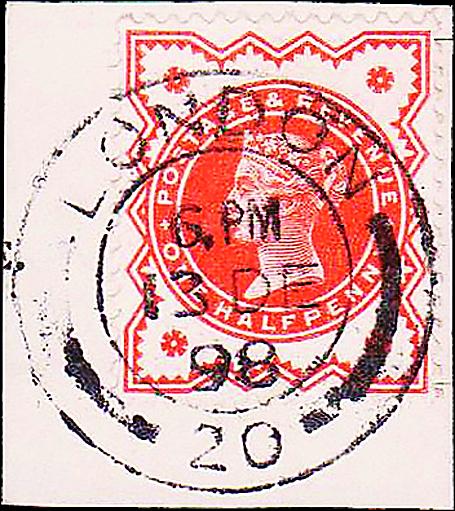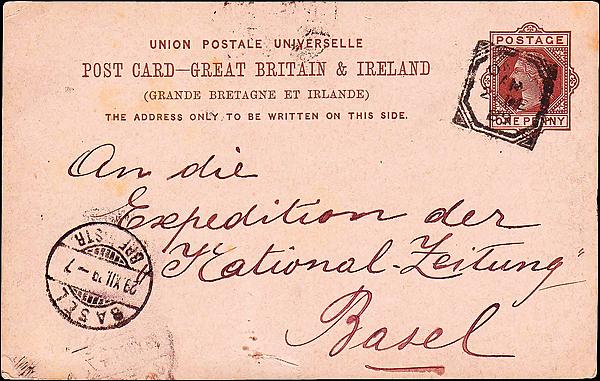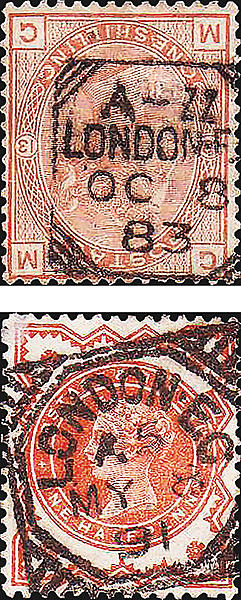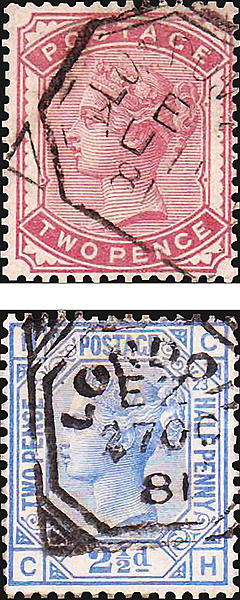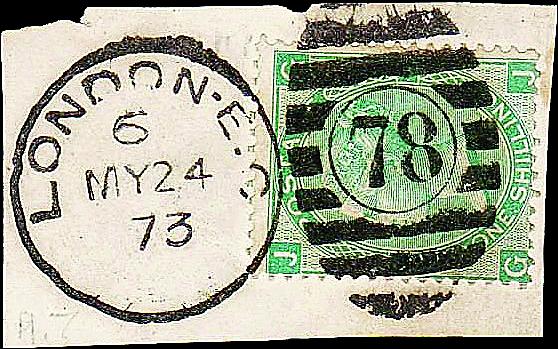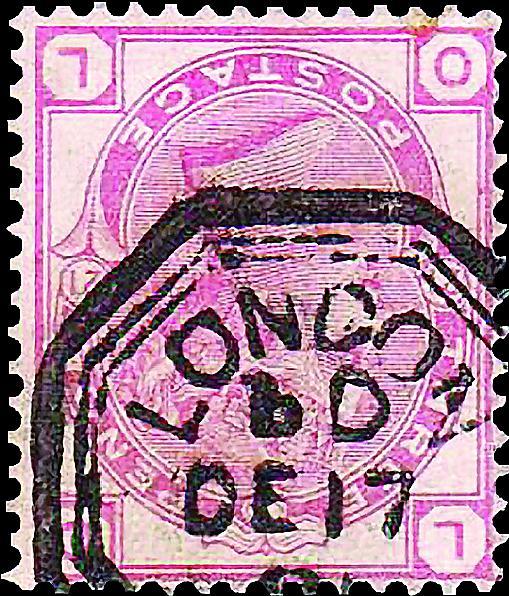World Stamps
London fancy geometric postmarks experiment began in 1880
The cancellation on the 3-penny rose Queen Victoria stamp (Scott 61) shown here makes the stamp vastly more interesting and desirable to collectors.
The stamp is shown upside down, oriented to the postmark. It is an example of the London fancy geometric postmark experiment conducted by the British Post Office between 1880 and 1883.
Starting in 1860, the common format of the cancellations applied to mail in Great Britain was a duplex obliterator. The 1-shilling pale green Queen Victoria stamp (Scott 64) shown on piece bears an example of the duplex obliterator.
It is called duplex because it consists of two elements on one device. On the right is the obliterator comprising heavy bars in the shape of an oval with a number in the center, which canceled the stamp. On the left is a circular postmark showing the location and date of mailing.
The devices used to apply the duplex cancellation were bulky, heavy and expensive to manufacture. They also tended to produce incomplete strikes.
After 20 years of use, postal authorities sought a new device that would combine the obliterator and postmark.
The first experimental design was introduced in the London Inland branch office in January 1880. It consisted of the three-frame octagon postmark borne by the stamp mentioned in the first paragraph.
A second design in the experiment retained the basic octagon shape but added triangles to the corners, which gave the original octagon a square look.
There are two subtypes of this design, one with the corners empty and another with the corners containing tiny triangles. An example of each can be seen on the 2d Queen Victoria stamp (Scott 81) and the 2½d Queen Victoria stamp (82) shown here.
Sometimes the triangles look like dots, and sometimes dirt and debris clogged the larger triangles and gave them a filled-in look.
A third design retained the basic octagon shape within a square but filled the four corner triangles with hash marks, either parallel to the hypotenuse or vertical to the hypotenuse of the triangles.
An example of each can be seen on the 1sh Queen Victoria stamp (Scott 65) and the ½d Queen Victoria stamp (111) shown here. The 1sh stamp is shown upside down, oriented to the postmark.
London fancy geometric postmarks are fairly easy to distinguish from other postmarks. The basic octagon shape is quickly recognizable. The place of mailing is always London: one of two London branch offices, either the Inland branch or the Lombard Street branch. A postmark from any office other than London or Lombard Street cannot be of the fancy geometric genre.
The date has to be after 1879. Examples of London geometric fancy postmarks have been found on stamps and covers dated as late as 1904.
The fancy geometrics are usually found on stamps that were concurrent with the 20 years of the experiment: Penny lilacs (Scott 88-89), Venetian reds (79), 2½d clarets (67), 2½d ultramarines (68), and contemporaneous higher denominations.
Some collectors prefer examples of London fancy geometric postmarks on cover. A 1d Queen Victoria postal card mailed to Basel, Switzerland, in 1889 and bearing a fancy geometric postmark is shown.
Covers bearing the postmarks are usually more difficult to acquire than used stamps or used stamps on piece.
Used single stamps bearing enough of the postmark to be legible are very collectible.
Ironically, none of the experimental octagonal or fancy geometric postmark devices was chosen to replace the duplex obliterator as the standard postmarking and canceling device. The new standard device favored by postal authorities and introduced throughout England in 1892 was a two-ring circular postmark.
The ½d Queen Victoria stamp (Scott 111) on piece shown above bears an example. This postmarking device was developed in Edinburgh, Scotland.
MORE RELATED ARTICLES
Headlines
-
Postal Updates
Oct 7, 2024, 5 PMUSPS plans to raise postal rates five times in next three years
-
US Stamps
Oct 7, 2024, 3 PMMcMurtrie dismissed as APS education director following Sept. 21 arrest
-
US Stamps
Oct 7, 2024, 12 PMVasiliauskas named president of Mystic Stamp Co.
-
US Stamps
Oct 6, 2024, 5 PMApgar souvenir card available
